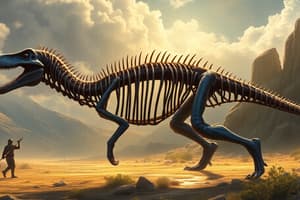Podcast
Questions and Answers
What is the primary purpose of categorizing and dating fossils from around the world?
What is the primary purpose of categorizing and dating fossils from around the world?
- To determine the evolutionary relationships between organisms (correct)
- To understand the geographical distribution of fossils
- To reconstruct the environmental conditions of the past
- To study the anatomy of extinct species
What is the significance of the pentadactyl appendage in different vertebrates?
What is the significance of the pentadactyl appendage in different vertebrates?
- It represents a convergent evolutionary adaptation
- It shows a unique characteristic of each species
- It is a vestigial structure with no functional significance
- It indicates a common developmental origin (correct)
What is the foundation of the comparative genomics approach in understanding evolutionary relationships?
What is the foundation of the comparative genomics approach in understanding evolutionary relationships?
- The comparison of embryonic development in different species
- The study of anatomical structures and their adaptations
- The analysis of DNA and protein sequences and their similarities (correct)
- The classification of organisms based on their morphological characteristics
What is the implication of the similarity in hereditary cosmetics between closely related species?
What is the implication of the similarity in hereditary cosmetics between closely related species?
What does the study of fossil record reveal about the evolution of form over time?
What does the study of fossil record reveal about the evolution of form over time?
What is the significance of the artist's rendition of extinct species of the genus Equus?
What is the significance of the artist's rendition of extinct species of the genus Equus?
What is the primary significance of homologous structures in the context of evolutionary biology?
What is the primary significance of homologous structures in the context of evolutionary biology?
What is the role of embryonic development in understanding evolutionary relationships?
What is the role of embryonic development in understanding evolutionary relationships?
What is the key difference between adaptation and modification in the context of evolution?
What is the key difference between adaptation and modification in the context of evolution?
What is the primary significance of comparative anatomy in the study of evolution?
What is the primary significance of comparative anatomy in the study of evolution?
What is the significance of phylogenetic relationships in the context of evolution?
What is the significance of phylogenetic relationships in the context of evolution?
What is the primary significance of atomic homology in proteins and qualities across species?
What is the primary significance of atomic homology in proteins and qualities across species?
How do comparative biology and the fossil record provide evidence for evolution?
How do comparative biology and the fossil record provide evidence for evolution?
What is the primary function of the modified leaves in the pitcher plant and Venus' flytrap?
What is the primary function of the modified leaves in the pitcher plant and Venus' flytrap?
What is the significance of embryonic development in understanding phylogenetic relationships?
What is the significance of embryonic development in understanding phylogenetic relationships?
What is the primary function of the modified leaves in the cactus?
What is the primary function of the modified leaves in the cactus?
What is the term used to describe the study of formative forms from fertilization to adulthood?
What is the term used to describe the study of formative forms from fertilization to adulthood?
What is the term used to describe the structures that are derived from a common ancestral structure but have evolved to serve different functions?
What is the term used to describe the structures that are derived from a common ancestral structure but have evolved to serve different functions?
Flashcards are hidden until you start studying
Study Notes
Fossil Record Evidence for Evolution
- The fossil record provides direct evidence of evolution, showcasing the dynamic changes of life over time, including transitions between major taxa.
- Fossils are categorized and dated to determine when organisms lived relative to each other, revealing the evolution of form over millions of years.
- The fossil record tells the story of the past, with examples including the evolution of humans and horses.
Biogeography Evidence for Evolution
- Biogeography provides evidence for evolution by analyzing the distribution of species across space and time.
DNA and Protein Sequence Evidence for Evolution
- DNA and protein sequences offer genetic evidence for evolution, with comparative genomics uncovering shared genetic codes and groupings.
- The closeness of species is reflected in the similarity of their genetic makeup, supporting the predictions of evolutionary hypotheses and substantiating the unity of life through common ancestry.
Homology Evidence for Evolution
- Homology, whether in anatomical structures or genetic groupings, strengthens the case for evolution.
- Homologous structures, such as the pentadactyl appendage found in different vertebrates, indicate shared developmental beginnings.
- Molecular homology in genes and proteins across species echoes the theme of common ancestry, supporting the idea that diverse life forms are variations of a common genetic theme.
Embryology Evidence for Evolution
- Embryology, the study of developmental forms from fertilization to adulthood, completes the mosaic of evidence supporting evolution.
- Similarities in embryonic development among diverse species reveal shared genetic pathways.
Examples of Evolutionary Adaptation
- Examples of evolutionary adaptation include the modified leaves of plants, such as the pitcher plant and Venus' flytrap, which trap and digest insects.
- The bright red leaves of the poinsettia, which resemble flower petals, and the modified leaves of cacti, which reduce water loss and provide protection from herbivores.
Studying That Suits You
Use AI to generate personalized quizzes and flashcards to suit your learning preferences.




